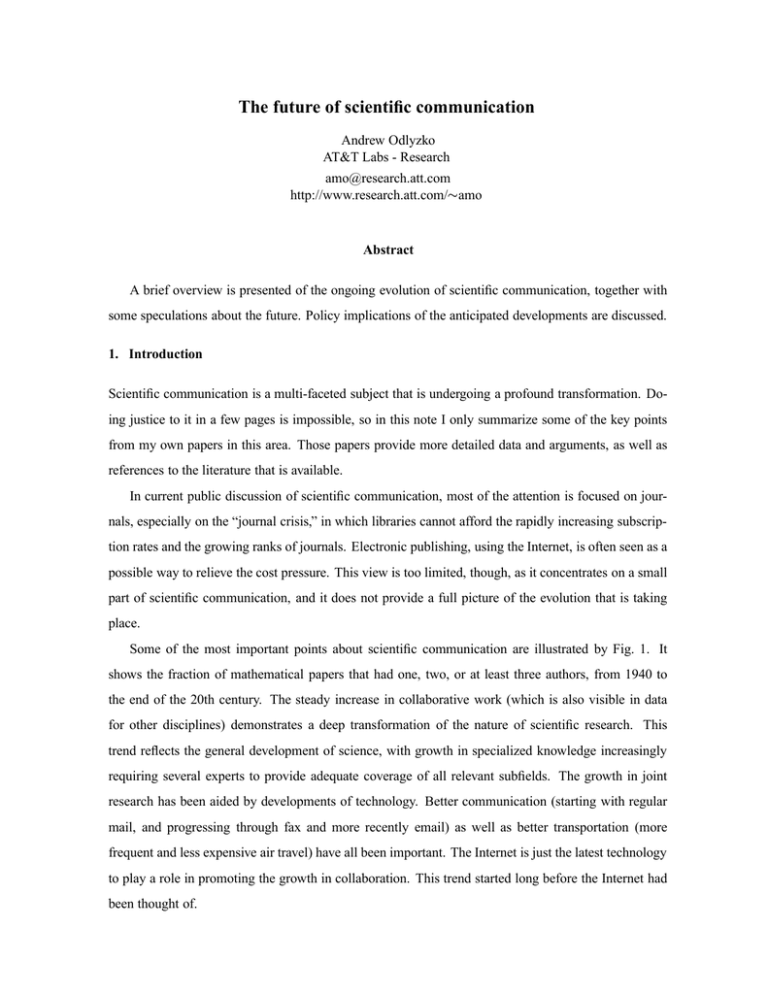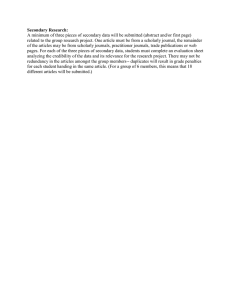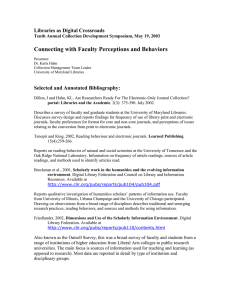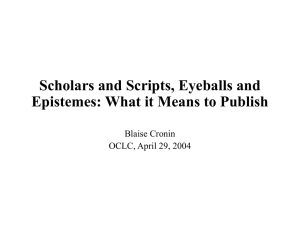The future of scientific communication
advertisement

The future of scientific communication Andrew Odlyzko AT&T Labs - Research amo@research.att.com http://www.research.att.com/ amo Abstract A brief overview is presented of the ongoing evolution of scientific communication, together with some speculations about the future. Policy implications of the anticipated developments are discussed. 1. Introduction Scientific communication is a multi-faceted subject that is undergoing a profound transformation. Doing justice to it in a few pages is impossible, so in this note I only summarize some of the key points from my own papers in this area. Those papers provide more detailed data and arguments, as well as references to the literature that is available. In current public discussion of scientific communication, most of the attention is focused on journals, especially on the “journal crisis,” in which libraries cannot afford the rapidly increasing subscription rates and the growing ranks of journals. Electronic publishing, using the Internet, is often seen as a possible way to relieve the cost pressure. This view is too limited, though, as it concentrates on a small part of scientific communication, and it does not provide a full picture of the evolution that is taking place. Some of the most important points about scientific communication are illustrated by Fig. 1. It shows the fraction of mathematical papers that had one, two, or at least three authors, from 1940 to the end of the 20th century. The steady increase in collaborative work (which is also visible in data for other disciplines) demonstrates a deep transformation of the nature of scientific research. This trend reflects the general development of science, with growth in specialized knowledge increasingly requiring several experts to provide adequate coverage of all relevant subfields. The growth in joint research has been aided by developments of technology. Better communication (starting with regular mail, and progressing through fax and more recently email) as well as better transportation (more frequent and less expensive air travel) have all been important. The Internet is just the latest technology to play a role in promoting the growth in collaboration. This trend started long before the Internet had been thought of. 40 60 1 author 20 percentage of papers 80 100 collaboration among mathematicians 2 authors 0 >= 3 authors 1940 1950 1960 1970 1980 1990 2000 year Figure 1. Fraction of mathematical papers with 1, 2, or more authors. Based on data provided by Patrick Ion from Mathematical Reviews. Fig. 1 also illustrates another important point, about the rate of change. The graph spans 60 years, or two generations. That is not “Internet time,” where major changes are claimed to occur in 18 months or less! In general, as is discussed in [Odlyzko4], sociological changes are slow, usually taking a generation or two. That is why we see little fundamental change in the nature of scholarly journals. At the same time, other changes are much more rapid. In particular, the migration of traditional journals to electronic formats is proceeding rapidly. 2. Journal evolution The ranks of free electronic journals run by scholars, without explicit financial support through grants or subscriptions, have been growing. However, their growth has been slower than many, including myself, had expected half a decade ago. On the other hand, traditional publishers, both commercial and non-profit ones, have been creating electronic versions of their established print journals at a rapid pace, more rapid than most had expected. Soon we are likely to see efforts to eliminate the paper versions entirely. This will have the effect of lowering costs of the library system, and might allow publishers to preserve their revenues at the expense of libraries [Odlyzko5]. The reason is that, as was pointed out in [Odlyzko1, Odlyzko5], most of the costs of research libraries are internal, and outside purchases of books and periodicals typically consume only a quarter to a third of the total library cost. Although there will be some resistance to the elimation of print versions of journals, their passing will 2 soon be seen as a positive development. The majority of scholars will quickly realize that it is much better to print an article on their desktop or departmental printer, as opposed to going to the library, finding the journal issue, photocopying it, and taking the copy back to their office. This will be an example of a relatively simple substitution that can take place in the space of a few years [Odlyzko4]. Electronic journals, even those which are exclusively electronic, tend to stick to traditional formats. The main reason is the inertia that was mentioned before. Journals are the most formal type of communication, and play a key role in grant, promotion, and tenure cases, and so academia is reluctant to tinker with them. There are numerous inadequacies of the traditional editorial and peer review system, as is discussed in [Odlyzko1]. They are a legacy of the print technology, which was all that we have had for the last few centuries. Many of those deficiencies can be overcome through more flexible systems that electronic publishing is making possible. However, changes of this type occur slowly, and few of them are visible in today’s electronic journals. Even though the basic format of scholarly journals is evolving slowly, drastic changes appears likely, possibly in the next decade or so. The importance of journals in scientific communication is rapidly declining. At some point, most likely during the next down part of the economic cycle, university presidents or other decision makers may decide that the huge resources devoted to traditional library collections would be better employed elsewhere. 3. Journals are not where the interesting action is Journals are just one part of scientific communication. Personal contacts, correspondence, and conferences have always been important. As mentioned in the Introduction, the trend shown in Fig. 1 has been facilitated by growth and improvements in communication and transportation. (See [Odlyzko7] for some statistics on the remarkable increase in volume of communications, such as a more than a 1000-fold rise in the number of pieces of mail delivered per person in the U.S. over the last two centuries.) The Internet has made possible a variety of new, much more flexible, forms of communications. What we can increasingly observe (see [Odlyzko6], for example) is vigorous growth in novel forms of scientific communication that take full advantage of the online medium. Growth rates are high, and if they continue for just a few years (as they show every sign of doing), these new forms will dominate. 4. The overwhelming importance of instant gratification Ease of access and use are paramount. Many scholars turn to Amazon.com for bibliographic help. The database is not as complete or scholarly as that of a major library, but it is more convenient to use. 3 In general, the volume of material on the Web is growing, and scholars, like the commercial content producers, are engaged in a “war for the eyeballs.” Furthermore, we are rapidly approching the stage that was predicted by Clifford Lynch in 1997 (as quoted in [StevensRB]): ... there’s a sense in which the journal articles prior to the inception of that electronic abstracting and indexing database may as well not exist, because they are so difficult to find. Now that we are starting to see, in libraries, full-text showing up online, I think we are very shortly going to cross a sort of critical mass boundary where those publications that are not instantly available in full-text will become kind of second-rate in a sense, not because their quality is low, but just because people will prefer the accessibility of things they can get right away. Some decry this tendency to settle for what is easy. However, it does lead to much more efficient use of time, eliminating all the drudgery of trips to the library. Easy access from one’s desktop (or increasingly from one’s mobile device) is leading to usage of serious scholarly material by a much wider audience, both of other scholars and the general population [Odlyzko6]. That trend is consistent with the general push for more interdisciplinary work, and also for more focused work [Odlyzko2]. Easy electronic access to scientific information is also changing the patterns of use. Much of what we have been used to was the artifact of print technology. Once the limitations of that technology are eliminated, behavior changes. With lower costs of access, a greater fraction of reading is of the superficial browsing variety. (However, that does not mean that there is less deep study, since there is general growth in information processing.) Older material is accessed much more frequently than before. 5. Conclusions and policy considerations The current evolution in scientific communication that is facilitated by the Internet is unavoidable and overwhelmingly desirable. It will produce a much more efficient system that will serve the scholarly community and the general population far better than the present one, which is based on Gutenberg’s invention. Policy makers can hasten the ongoing evolution by steps such as those advocated in [Bachrach], which would require scholars to make preprints of their papers freely available on the Web. However, such steps might be construed as interfering with the workings of the market. They would force publishers to adjust much faster than they are doing now, and that might lead to fears of disruption in 4 employment patterns. A less controversial step would be for policy makers to promote digitization of older material so as to make it freely available. It would not be expensive to do, as the evidence I have presented in several papers (for example, [Odlyzko3]) shows. The copyright issue could be solved, I believe, through negotiations with publishers. They currently derive negligible income from sales of back issues, and so should be willing to sell the right to distribute digitized material for moderate fees. That policy would promote public good by lowering costs of maintaining traditional libraries, and, much more important, by making available material that would otherwise become neglected. References [Bachrach] S. Bachrach, R. S. Berry, M. Blume, T. von Foerster, A. Fowler, P. Ginsparg, S. Heller, N. Kestner, A. Odlyzko, A. Okerson, R. Wigington, and A. Moffat, Who should own scientific papers?, Science 281 (no. 5382) (Sept. 4, 1998), pp. 1459-1460. Available at http://www.research.att.com/ amo . [Odlyzko1] A. M. Odlyzko, Tragic loss or good riddance? The impending demise of traditional scholarly journals, Intern. J. Human-Computer Studies (formerly Intern. J. Man-Machine Studies) 42 (1995), pp. 71–122. Also in the electronic J. Univ. Comp. Sci., pilot issue, 1994, http://hyperg.iicm.tu-graz.ac.at . Available at http://www.research.att.com/ amo . [Odlyzko2] A. M. Odlyzko, The decline of unfettered research, 1995 manuscript, available at http://www.research.att.com/ amo . [Odlyzko3] A. M. Odlyzko, The economics of electronic journals, First Monday 2(8) (August 1997), http://firstmonday.org/ . Also pp. 380–393 in Technology and Scholarly Com munication, R. Ekman and R. E. Quandt, eds., Univ. Calif. Press, 1999. Available at http://www.research.att.com/ amo . [Odlyzko4] A. M. Odlyzko, The slow evolution of electronic publishing, pp. 4–18 in Electronic Publishing - New Models and Opportunities, A. J. Meadows and F. Rowland, eds., ICCC Press, 1997. Available at http://www.research.att.com/ amo . [Odlyzko5] A. M. Odlyzko, Competition and cooperation: Libraries and publishers in the transition to electronic scholarly journals, J. Electronic Publishing, 4(4) (June 1999), 5 http://www.press.umich.edu/jep/ , J. Scholarly Publishing 30(4) (July 1999), pp. 163–185. Available at http://www.research.att.com/ amo . [Odlyzko6] A. M. Odlyzko, The rapid evolution of scholarly communication. Available at http://www.research.att.com/ amo . [Odlyzko7] A. M. Odlyzko, The history of communications and its implications for the Internet, available at http://www.research.att.com/ amo . [StevensRB] S. Stevens-Rayburn and E. N. Bouton, “If it’s not on the Web, it doesn’t exist at all”: Electronic information resources - Myth and reality, available at http://www.eso.org/gen-fac/libraries/lisa3/stevens-rayburns.html . 6


